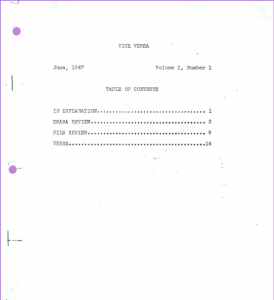 VICE VERSA
VICE VERSA
One of the pleasures, many pleasures, of research is stumbling on the unknown. So, I’ve been reading a bit about the 1940s, trying to understand the context for Dark Dominion, published in 1947. WOLF-WOMEN AND PHANTOM LADIES, by Steven Dillon, is a recent academic book about pop culture and women’s desire in the 40’s, which is right up my alley, and in that book I found a reference to the first lesbian magazine, Vice Versa, hand-typed (with carbon paper) by the editor, Lisa Ben (pseudonym), and given to her friends. Each issue (there were 10 in all) was distributed to about 10 people, who passed it on. Ben has been recognized, lauded, and documented, but I’d never heard of her, and spent Sunday morning reading Vice Versa online.
Dillon’s book is absorbing, clearly written and intelligent, so I’m really looking forward to finishing it. I was a bit disappointed that Hauser, whose Dark Dominion is mentioned in it, in a chapter on women’s magazines, somehow eludes the index! This is one of the very few critical works to even mention Dark Dominion.
The neglect of her work before The Talking Room is puzzling, given how important and brilliant that book is. I would think people would be interested in where she came from. The few critical works about her have focused on gender and sexuality, which makes sense. But without knowing anything about her earlier work critics can do weird things. Friedman and Fuchs, writing about women’s experimental fiction (Breaking the Sequence: Women’s Experimental Fiction, Princeton, NJ: Princeton University Press, 1989), put Hauser in the 3rd generation of women experimentalists, with Kathy Acker of all people. Superficially this works, but scholarship isn’t supposed to be superficial, and creating a genealogy of style without knowing the genealogy of the individual writer is crazy.
Hauser is most like Djuna Barnes in attitude, a second generation experimentalist. Hauser came of age in the 1930s. Her earliest memories are of World War 1. She lived in Paris and was widely traveled. She was deeply affected by reading Celine’s Journey to the End of Night, in French, when it was published. Dark Dominion, a book of the forties, is immersed in the European literature of the inter-war years. It has much in common with The Talking Room, although it is more constrained.
Hauser was a working writer when she came to NYC in 1937, and while she was writing Dark Dominion not only was she in the heart of NY literary culture, she was reviewing books. Lots and lots of books. Most of them are forgettable, but a few stand out and indicate that she was always aware of, and always working within, an experimental context. She reviewed Gertrude Stein’s Ida. Her close friend Marguerite Young reviewed Hermann Broch’s The Death of Virgil. Dark Dominion was reviewed by Elizabeth Hardwick in the Partisan Review alongside Malcom Lowry’s Under the Volcano. Beyond this she was associated with Carson McCullers and Truman Capote, and she also wrote important reviews (still quoted) on Eudora Welty. They are not normally thought of as experimentalists. They were not radical, avant-garde writers but they were writing in a tradition of serious literary fiction that was deeply influenced by Joyce and Faulkner, by surrealism and symbolism and Hauser, like them, was not a conventional realist. (And Capote’s In Cold Blood IS experimental, if you consider what he is up to, and the precedent for that book, the first piece of Gonzo journalism, James Agee’s Let Us Now Praise Famous Men). Dismissed as ‘gothic’ (see Wolf-Women and Phantom Ladies) they were working at a time when mainstream publishers were interested in serious and challenging fiction in a way that would NOT be true 30 years later, when The Talking Room was published by the Fiction Collective. Of course, much else had changed, especially in the realm of censorship. If America was sex obsessed in the 1940s there were still limits on what authors could write and send through the mail. When that changed the lid blew off and Hauser could give free rein to her imagination.
